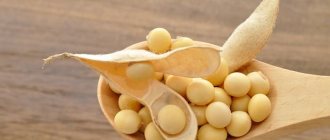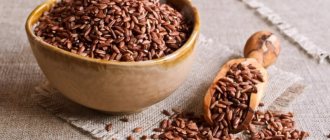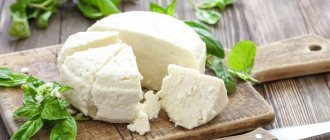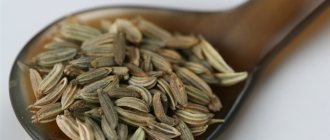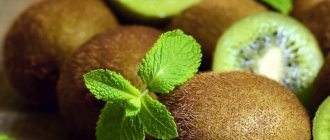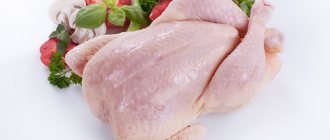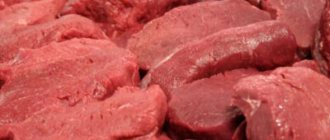What is soy
This is a type of annual plant from the legume group along with peas, lentils and beans. It reaches a height of about 2 meters. There are different types of soy:
- Manchurian;
- Korean;
- Chinese;
- Indian.
It is one of the most popular and affordable plant proteins used to produce meat, cheese and milk substitutes. For persons who do not consider themselves to be athletes, such a replacement is quite acceptable. Soy is especially common among those who follow a vegan diet. Previously, it was believed that soy products were only harmful, but after a series of studies it was proven that such raw materials have several beneficial properties due to their unique composition.
Chemical composition
Soy has become popular due to its high protein content, which contains amino acids essential for the body. Depending on its variety, the level of these nutrients can vary from 30 to 50%. The composition of soybeans, in addition to proteins, includes the following components:
- folic acid;
- iodine;
- calcium;
- phosphorus;
- iron;
- vitamin E;
- potassium;
- magnesium;
- vitamin B1;
- amino acids – arginine, histidine, methionine, tryptophan, phenylalanine, valine, lysine, glycine, serine, cysteine;
- fatty acid;
- phytoestrogens;
- sucrose, glucose, fructose.
Calories and nutritional value
The protein in this variety of beans has a heterogeneous structure, so the body well absorbs about 70% of the total amount of this nutritional component. The levels of other nutrients are as follows:
- fats – 16-27%;
- saturated fatty acids – 13-14%;
- unsaturated fatty acids – 87%.
Soy also contains carbohydrates in a mass fraction of about 30 g per 100 g of product. Additionally, this plant contains rare substances – isoflavones, which have estrogenic activity. The calorie content of soybeans is determined by the maturity of the beans. Unripe beans have a nutritional value of approximately 147 calories per 100 g. For mature beans, the same figure is already 446 kcal per 100 g.
Harm of soy to the thyroid gland
It has been proven that isoflavones can work as goitrogens - substances that interfere with the normal functioning of the thyroid gland, making it difficult to absorb iodine. The result of this exposure is the growth of the thyroid gland (goiter).
According to most studies, soy negatively affects the thyroid gland in those people who already suffer from hypothyroidism, for example, congenital. Or with a very massive inclusion in the diet.
However, there is other data. So in Japan, a study was conducted when healthy adults received soy isoflavones daily in an amount equal to only 30 g of beans per day. And after three months they showed obvious symptoms of insufficient thyroid function: goiter, constipation, drowsiness, etc.
What are the benefits of soybeans?
It is an excellent basis for weight loss, because it combines complete protein compounds and a small amount of saturated fatty acids, which is typical for meat and dairy products. Numerous beneficial properties of soy are due to the substances it contains:
- Phospholipids. They regenerate cell membranes, normalize the ability of liver cells to detoxify, and act as antioxidants. Additionally, phospholipids reduce the need for insulin in diabetics and improve thinking.
- Lecithin. Stimulates metabolism, cholesterol and fat metabolism, and together with choline helps the liver burn excess fat deposits faster. In addition, lecithin has choleretic and lipotropic effects.
- Polyunsaturated fatty acids. They prevent cholesterol from accumulating in the walls of blood vessels, which prevents atherosclerosis.
- Tocopherol. A high level of this component strengthens the body's defenses, increases potency and slows down the aging process.
Indications and contraindications for use
Soybean dishes are consumed not only to diversify the diet, but also for certain indications. The beneficial effect of this product on the body helps improve the condition of certain diseases. Their list includes:
- arthrosis and arthritis;
- myocardial infarction;
- cholecystitis;
- chronic constipation;
- hypertension;
- ischemia;
- allergy to animal protein;
- atherosclerosis;
- gout
Soy is not always beneficial, so it is contraindicated for some diseases and conditions of the body. It is necessary to limit its use during pregnancy. Due to the presence of hormone-like substances in the composition, soy food can negatively affect the development of the embryo. It is also prohibited for young children whose hormonal levels have not yet been fully formed. Other contraindications to consuming soy:
- endocrine diseases;
- problems with cerebral circulation;
- urolithiasis;
- old age (due to the possible development of Alzheimer's disease).
Are soy products harmful to men's health?
Many scientific copies have been broken about the answer to the question of how soy products affect the body of men, especially their genital area.
Soy contains phytoestrogens. Therefore, its presence in the diet of men is alarming. However, until now there have been no truly serious scientific studies that would clearly prove the harm or benefit of soy for men's health.
- Supporters of the use of soy foods refer to research data that proves the product’s harmlessness for men and even their therapeutic effects. For example, they say that such a diet helps prevent prostate cancer. Or they claim that they have proven that soy cannot cause feminization in men.
- Opponents categorically disagree with such arguments. Since some of the studies confirming safety are sponsored by those who sell and advertise this legume. And even “pure” research is observational, that is, observational. And the data from such reviews do not have full scientific validity.
- In turn, soy supporters accuse its opponents of conducting experiments on animals, which also cannot be correctly extrapolated to humans. Or they take too small a sample that does not have statistical significance.
It is still unclear who is right in this dispute. But in any case, many nutritionists advise men to consume fermented soy products in quantities not exceeding 1-2 servings per day, for example, one glass of milk and a small piece of tempeh per day.
Soy in food
Soybeans are widely used in the modern production of a wide variety of products. All of them are distinguished by a high concentration of protein and lecithin. It is not recommended to consume them often, but if used in moderation in food, they will benefit the body by improving overall well-being. Types of soy products:
- dairy;
- flour;
- meat;
- paste;
- vegetable oil;
- soy sauce;
- pace;
- yuba;
- chocolate.
Dairy soy products
The first soy-based product is milk. It is a pleasant white drink with a delicate aroma. To make milk, soybeans are crushed, soaked and squeezed, and the resulting liquid is calcined. The finished product is ideal for baby food if babies are prone to allergies to regular dairy products. Soy does not contain lactose and contains little fiber, so it does not cause diathesis.
Adults can add this milk to coffee, tea, porridge and other dishes. In addition, the following fermented milk products are prepared from soy:
- Yogurt, kefir. They practically do not differ from ordinary ones, they contain a minimum of animal fats, therefore they are used for vegan nutrition.
- Cheese Tofu. It is well absorbed, does not contain cholesterol, promotes the restoration of bone and muscle tissue, strengthens them, and prevents the formation of cancer cells. Can be frozen, has a specific slight odor of ammonia.
Flour from meal or dry beans
The basis for flour is soybean seeds or meal obtained during the production of oil from them. Its advantage is the large amount of microelements and proteins in its composition. In addition, this flour does not contain starch, therefore it is useful for obesity and diabetes. It can be used instead of eggs at the rate of: 2 tbsp. l. flour for 1 egg. Flour is also used in the production of sausages and frankfurters, which makes them more dietary. It is difficult to make flour products from it due to its low gluten content. To prepare them, you need to add about 70-80% wheat flour.
Soy meat
It is obtained by extrusion cooking based on defatted soy flour. The entire manufacturing process can be briefly described as follows:
- it all starts with pressing a certain size of doughy textured protein through a “sieve”;
- At the end of the procedure, it is dried.
Depending on the size of the sieve holes, the meat can have different granule sizes: from very small (used for preparing minced meat) to small pieces. The product is sold dry in the store. After soaking, it increases its size up to 4 times. This “meat” can be consumed by everyone, because it is absolutely natural. In addition, it has little cholesterol and very low calorie content, so the product is perfect for a diet.
Fermented miso paste
It is a product of fermentation of soybean paste by mold fungi. It is considered an indispensable ingredient for Japanese cuisine along with rice. Paste reduces the negative effects of cholesterol and external environmental factors on the body. The latter even includes radiation. The paste is used to make miso soup. It is ideal for breakfast because it gives you a boost of energy for the whole day. To prevent liver diseases, it is recommended to eat a spoonful of paste daily. The following dishes are also prepared based on this soy product:
- light soups - misosiru;
- snacks – miso-dengaku;
- thick solyanka soups – isiaki-nabe;
- main courses with the addition of rice, green onions and cucumber.
Vegetable oil from soybean seeds
This type of oil is widespread in America. It is highly digestible and has a slight nutty flavor. For its production, the method of pressing soybeans is used. The oil is beneficial due to the presence of unsaturated fatty acids. An example is linoleic acid, which prevents the development of cancer cells. It is recommended to consume soybean oil for diseases of the kidneys and nervous system. The product is added to salads, cold and hot dishes. Industrial production uses this oil in the manufacture of:
- margarine;
- vegetable cream;
- mayonnaise;
- of bread.
- System minus 60 by Ekaterina Mirimanova for weight loss
- Beetroot with kefir for weight loss - recipes and reviews. Recipes for beetroot-kefir diet for weight loss
- Trigeminal neuralgia - causes, symptoms, treatment with anticonvulsants and folk remedies
Soy sauce
This soy product is made by fermenting beans, just like the Japanese dish natto. The process takes at least six months. At the end, the sauce is diluted with water, adding a little sea salt. It is widely used as a salad dressing and an addition to side dishes. Fried meat that is pre-marinated in soy sauce turns out delicious. It is also used when eating sushi or rolls. The product is useful for its antioxidant properties. This means that the sauce is able to remove free radicals and other toxins from the body.
Tempe
It is a fermented food product made from whole soybeans. They are softened, opened or peeled, and then boiled, but not completely. Next, a starter with a fungal culture or an acidifier is added to the boiled beans. At the end they are placed in a thin layer, and then fermented for 24 hours at 30 degrees. The finished product is very rich in protein. Tempeh is used by vegetarians. It is cut into pieces, then fried in oil, adding other ingredients. Tempeh is served in soups, with a side dish or as a separate dish.
Yuba
Otherwise called fuli, fuzhu or doupi. Yuba is the surface foam of soy milk, used in dry or raw form. This ingredient belongs to East Asian cuisine. In Russia, yuba is known as “soy asparagus,” although it has nothing to do with asparagus. Soy milk is boiled, resulting in a hard layer called yuba appearing on the surface. It contains a lot of fat. Using special equipment, the film is removed and hung to dry. They prefer to eat fuzhu fresh as a snack or dipped in sauce.
Soy chocolate
It is a dietary analogue of regular chocolate. During production, cocoa beans are replaced with soybeans. The benefit of such chocolate is that its calorie content is much lower compared to regular sweets. For this reason, it is widely used in dietary nutrition. Soy chocolate is especially recommended for people suffering from excess weight.
Soy lecithin
It is an ingredient in most store-bought baked goods. Lecithin is necessary to give creams the desired consistency. The substance is produced using the technology of processing vegetable oil from castor bean seeds and the fatty alcohol glycerin. Lecithin is a viscous liquid with an oily consistency, dark yellow in color. The substance acts as a thickener in squash caviar, mayonnaise, margarine, chocolate, pates and instant soups. With regular use, lecithin can cause enlargement of internal organs.
What are the types of soy products?
- Whole beans. Ripe varieties are rarely eaten entirely. But unripe green ones - edadam - are actively used in Asian countries as a snack.
- Soy milk. Obtained from whole beans by soaking and then grinding.
- Tofu is cottage cheese (cheese) made from milk.
- Soy sauce is made from beans that have been fermented by Aspergillus molds.
- Miso is a thick paste also made from fermented Aspergillus beans.
- Natto is a whole bean fermented by Bacillus subtilis.
- Tempeh is also fermented whole beans, but a different culture is used for fermentation - Rhizopus oligosporus, and after fermentation it is pressed into briquettes.
- Soy meat, or textured meat, is a product obtained from defatted soy flour, which remains after the oil is squeezed out.
- Protein isolate. This is a dietary supplement obtained from highly processed beans.
This article is devoted to the influence of the beans themselves on the human body, as well as those products that have not undergone fermentation, which significantly changes the properties of soy foods.
Harm to the body
Soybeans have a depressant effect on the endocrine system. With their frequent use, especially in children, problems with the thyroid gland develop. In children under 3 years old, beans can cause allergies. Among other harmful properties of this plant are:
- acceleration of the aging process;
- cerebrovascular accident;
- increased likelihood of Alzheimer's disease;
- increased risk of miscarriage;
- negative impact on the development of the child’s brain in the womb.
Soy sausages: composition and nutritional value
Soy sausages
Soy bean sausages are a nutritious and healthy alternative to traditional meat products for those who follow a vegetarian or vegan diet. They contain up to 50% easily digestible vegetable protein and retain phytoestrogens, amino acids, minerals and vitamins after heat treatment. Regular consumption promotes:
- reducing sugar and cholesterol levels;
- improving digestion;
- normalization of heart rate;
- preventing aging;
- stabilization of metabolism, blood pressure and hematopoiesis.
The sausages contain boiled beans or tofu, sauce, spices, vegetable oil, onions, garlic and mustard.
Information sources
Where to buy soybeans for cooking
It is sold in any Korean or Japanese food stores. You can sometimes buy soy meat, like other similar products, at the market. For active Internet users, it will be more convenient to order them in an online store with home delivery, and sometimes you can get a discount when purchasing. Among the domestic companies from which you can purchase soy food, the following stand out:
- COMPANY ;
- association of soybean processors "ASSOYA";
- Inter Soya LLC;
- Soy Products LLC;
- JSC "Belok"
Helps build muscle
Unlike most other plant proteins, soy protein is a complete protein.
This means that it contains all the essential amino acids that the body cannot produce and must be obtained from food.
While every amino acid plays a role in muscle protein synthesis, branched chain amino acids (BCAAs) are the most important when it comes to building muscle (2, 3).
One study found that people who drank 5.6 grams of BCAAs after resistance training had a 22% increase in muscle protein synthesis, compared to people who received a placebo (4).
Specifically, the BCAA leucine promotes muscle protein synthesis and helps build muscle (5, 6).
Compared to whey and casein proteins, soy protein falls somewhere in the middle when it comes to muscle protein synthesis.
One study found that soy protein was inferior to whey protein for muscle protein synthesis but performed better than casein. Researchers concluded that this may be related to the rate of digestion or leucine content (7).
Likewise, a review study found that whey protein supported muscle protein synthesis better than soy protein in young and older adults (8).
Interestingly, soy may benefit you best when combined with other proteins.
Some research suggests that combining milk and soy proteins may result in greater muscle protein synthesis than whey, casein, or soy proteins alone (9).
Summary:
Although soy protein contains the BCAA leucine and does increase muscle protein synthesis to some extent, it appears to be inferior to whey protein in terms of muscle building.
How much do soybean products cost?
Before you buy soybeans in Moscow, St. Petersburg or any other city, you need to study the prices for products made from this raw material. The cost depends on the manufacturer and place of purchase. Specific price examples:
| Name | Quantity | Price, in rubles |
| Fuzhu | 0.5 kg | 156 |
| Vegetable cream | 0.5 kg | 149 |
| Frozen green beans | 0.5 kg | 156 |
| Flour | 100 g | 152 |
| Meat | 1 kg | 128 |
| Sauce | 500 ml | 168 |
| Lecithin | 1 kg | 78 |
| Tofu | 175 g | 95 |
Expert opinion
Ekaterina Vasilyeva, dermatocosmetologist, Federal State Unitary Enterprise “Institute of Plastic Surgery and Cosmetology of the Ministry of Health and Social Development of the Russian Federation”
I vote for soy with both hands. Products made from it bring health, youth and beauty. The vitamins found in beans are powerful immunomodulators. Protein is easily digestible, a feeling of fullness is achieved quickly, and a person does not overeat, so soybeans are recommended for those who are watching their figure. The fiber in beans helps cleanse the body of waste substances. But still, soy cannot replace all products. Plant protein is different from animal protein, so you shouldn’t completely give up meat, cottage cheese or milk. In everything you need to know when to stop.
Video
Soy products: harm and benefit. Soy products. Soy meat
What are the benefits of Soy Milk?
Soy - benefits and harm. Soy norm, soy products
Soy milk: is there any specific benefit or harm?
This drink is made from soaked and ground beans. Store-bought versions usually have additional ingredients, such as flavorings, sweeteners, or extra minerals and vitamins, to increase the benefits of the product.
Because the drink may contain additional ingredients, it is difficult to provide its exact nutritional value. The following data is usually given (per glass of unsweetened milk):
- calorie content about 100 kcal;
- fiber 1.5-1.6 g (6% of daily value);
- 6-8 g protein;
- 22-25% of the daily dose of manganese;
- 15-16% copper, iron, folate;
- 12-13% phosphorus, magnesium;
- 9-10% vitamins K, B1, B2, potassium.
The health benefits and health impacts of milk are the same as those of any other soy product made from unfermented beans.
The drink can help prevent heart and vascular diseases and have a positive effect on the state of the female hormonal system. Possibly has a negative effect on the thyroid gland and sexual health of men.
Can cause allergies.
But diarrhea from milk is less common than from some other types of soy products, since it contains less fiber.
